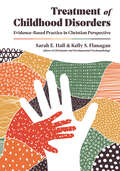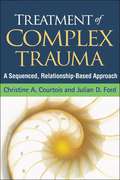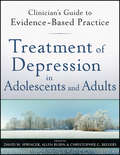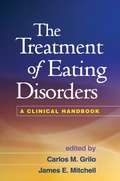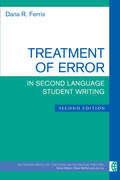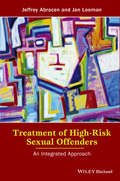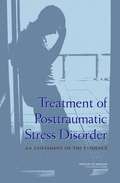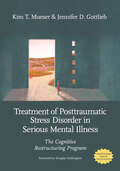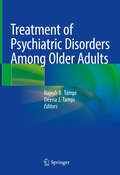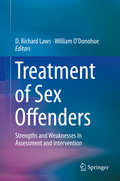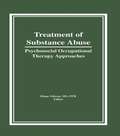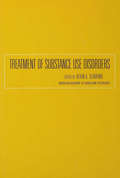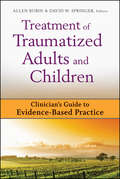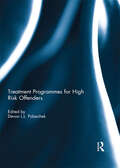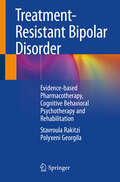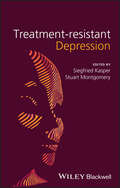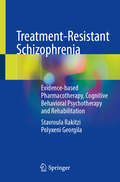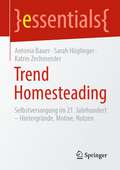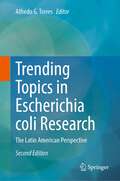- Table View
- List View
Treatment of Childhood Disorders: Evidence-Based Practice in Christian Perspective (Christian Association for Psychological Studies Books)
by Kelly S. Flanagan Sarah E. HallCaring for the mental health of children and their families is complex and challenging—and meaningful. For Christian clinicians who work with childhood disorders, however, few resources exist to address such treatment from a research-based Christian integration perspective. Treatment of Childhood Disorders fills this gap by combining biblical and theological understanding with current psychological literature on empirically supported treatments for children. Sarah E. Hall and Kelly S. Flanagan present an integrated approach based in developmental psychopathology, which offers a dynamic, multifaceted framework from which to understand the processes that affect children's development. In this unique textbook, Hall and Flanagan consider a variety of disorders commonly diagnosed in children and adolescents, including anxiety, depression, ADHD, and autism spectrum disorder. After discussing prevalence, risk and causal factors, patterns throughout development, and assessment, they focus on evidence-based practices that have been found to be effective in treating the disorders. Each chapter also features ideas for Christian integration in treatment and an extended case study that brings the content to life.
Treatment of Complex Trauma
by Julian D. Ford Christine A. CourtoisThis insightful guide provides a pragmatic roadmap for treating adult survivors of complex psychological trauma. Christine Courtois and Julian Ford present their effective, research-based approach for helping clients move through three clearly defined phases of posttraumatic recovery. Two detailed case examples run throughout the book, illustrating how to plan and implement strengths-based interventions that use a secure therapeutic alliance as a catalyst for change. Essential topics include managing crises, treating severe affect dysregulation and dissociation, and dealing with the emotional impact of this type of work. The companion Web page offers downloadable reflection questions for clinicians and extensive listings of professional and self-help resources. See also Drs. Courtois and Ford's edited volume, Treating Complex Traumatic Stress Disorders, which presents research on the nature of complex trauma and reviews a range of evidence-based treatment models for adults.
Treatment of Complex Trauma
by Julian D. Ford Christine A. Courtois John BriereThis insightful guide provides a pragmatic roadmap for treating adult survivors of complex psychological trauma. Christine Courtois and Julian Ford present their effective, research-based approach for helping clients move through three clearly defined phases of posttraumatic recovery. Two detailed case examples run throughout the book, illustrating how to plan and implement strengths-based interventions that use a secure therapeutic alliance as a catalyst for change. Essential topics include managing crises, treating severe affect dysregulation and dissociation, and therapist self-care. The companion website offers downloadable reflection questions for clinicians and extensive listings of professional and self-help resources. A new preface in the paperback and e-book editions addresses key scientific advances. See also Drs. Courtois and Ford's edited volumes, Treating Complex Traumatic Stress Disorders (Adults) and Treating Complex Traumatic Stress Disorders in Children and Adolescents, which present research on the nature of complex trauma and review evidence-based treatment models. Winner (Second Place)--American Journal of Nursing Book of the Year Award, Psychiatric and Mental Health Nursing Category
Treatment of Depression in Adolescents and Adults
by Allen Rubin David W. Springer Christopher G. BeeversEvidence-based interventions for treating depression in adolescents and adults Part of the Clinician's Guide to Evidence-Based Practice Series, Treatment of Depression in Adolescents and Adults provides busy mental health practitioners with detailed, step-by-step guidance for implementing clinical interventions that are supported by the latest scientific evidence. This thorough, yet practical volume draws on a roster of experts and researchers in the field who have assembled state-of-the-art knowledge into this well-rounded guide. Each chapter serves as a practitioner-focused how-to reference and covers interventions that have the best empirical support for the treatment of depression, including: Cognitive Behavior Therapy Behavioral Activation Cognitive Behavioral Analysis System of Psychotherapy for Chronic Depression Easy to use and accessible in tone, Treatment of Depression in Adolescents and Adults is indispensable for practitioners who would like to implement evidence-based, culturally competent, effective interventions in their care of clients struggling with depression.
Treatment of Eating Disorders
by James Mitchell Carlos GriloEminently practical and authoritative, this comprehensive clinical handbook brings together leading international experts on eating disorders to describe the most effective treatments and how to implement them. Coverage encompasses psychosocial, family-based, medical, and nutritional therapies for anorexia nervosa, bulimia nervosa, binge-eating disorder, and other eating disorders and disturbances. Especially noteworthy are "mini-manuals" that present the nuts and bolts of 11 of the treatment approaches, complete with reproducible handouts and forms. The volume also provides an overview of assessment, treatment planning, and medical management issues. Special topics include psychiatric comorbidities, involuntary treatment, support for caregivers, childhood eating disorders, and new directions in treatment research and evaluation.
Treatment of Error in Second Language Student Writing, Second Edition
by Ferris Dana R.Treatment of Error offers a realistic, well-reasoned account of what teachers of multilingual writers need to know about error and how to put what they know to use. As in the first edition, Ferris again persuasively addresses the fundamental error treatment questions that plague novice and expert writing specialists alike: What types of errors should teachers respond to? When should we respond to them? What are the most efficacious ways of responding to them? And ultimately, what role should error treatment play in the teaching of the process of writing? The second edition improves upon the first by exploring changes in the field since 2002, such as the growing diversity in what is called L2 writers, the blurring boundaries between native and non-native speakers of English, the influence of genre studies and corpus linguistics on the teaching of writing, and the need the move beyond error to second language development in terms of approaching students and their texts. It also explores what teacher preparation programs need to do to train teachers to treat student error. The second edition features * an updating of the literature in all chapters * a new chapter on academic language development * a postscript on how to integrate error treatment/language development suggestions in Chapters 4-6 into a writing class syllabus * the addition of discussion/analysis questions at the end of each chapter, plus suggested readings, to make the book more useful in pedagogy or teacher development workshops"
Treatment of High-Risk Sexual Offenders
by Jeffrey Abracen Jan LoomanTreatment of High-Risk Sexual Offenders addresses concrete management strategies, from initial intake to community treatment programs, and describes a detailed program for high risk offenders which has been developed, tested and refined for over 15 years. Provides a thorough review of contemporary theory and research relating to complex, challenging populations, and translates it into a comprehensive system of assessment and treatment for high risk sexual offenders Offers detailed coverage of setting and staff requirements, the importance of the therapeutic alliance, and how to balance individual therapy with group components in order to develop social and self-management skills Builds on the principle of integrative care, drawing on the established Risk-Need-Responsivity (RNR) model for offender assessment and rehabilitation but adding new components of CBT and motivational interviewing Includes a complete assessment battery and strategies for managing serious mental illness and comorbidity
Treatment of Post-traumatic Stress Disorder: An Assessment of the Evidence
by Institute of Medicine Committee on Treatment of Posttraumatic Stress Disorder StaffMental disorders, including posttraumatic stress disorder (PTSD), constitute an important health care need of veterans, especially those recently separated from service. Treatment of Posttraumatic Stress Disorder: An Assessment of the Evidence takes a systematic look the efficacy of pharmacologic and psychological treatment modalities for PTSD on behalf of the Department of Veterans Affairs. By reviewing existing studies in order to draw conclusions about the strength of evidence on several types of treatment, the Committee on the Treatment of Posttraumatic Stress Disorder found that many of these studies were faulty in design and performance, and that relatively few of these studies have been conducted in populations of veterans, despite suggestions that civilian and veteran populations respond differently to various types of treatment. The committee also notes that the evidence is scarce on the acceptability, efficacy, or generalizability of treatment in ethnic and cultural minorities, as few studies stratified results by ethnic background. Despite challenges in the consistency, quality, and depth of research, the committee found the evidence sufficient to conclude the efficacy of exposure therapies in treating PTSD. The committee found the evidence inadequate to determine efficacy of different types of pharmacotherapies, of three different psychotherapy modalities, and of psychotherapy delivered in group formats. The committee also made eight critical recommendations, some in response to the VA's questions related to recovery and the length and timing of PTSD treatment, and others addressing research methodology, gaps in evidence and funding issues.
Treatment of Posttraumatic Stress Disorder in Serious Mental Illness: The Cognitive Restructuring Program
by Kim T. Mueser Jennifer D GottliebThis book is a practical guide to the evidence-based Cognitive Restructuring (CR) for PTSD program, which has been specifically designed to meet the unique needs of people with serious mental illness. Posttraumatic stress disorder (PTSD) is very common among persons with serious mental illness (SMI). Unfortunately, it often leads to more severe psychiatric symptoms, greater impairment in psychosocial functioning, poorer physical health, and a higher use of acute care services among people with SMI. Yet despite major advances in the treatment of PTSD in the general population, PTSD has remained underdiagnosed and underaddressed among people with SMI, and treatments for this population have been relatively neglected. This practical, hands-on guide gives clinicians the tools they need for screening, detecting, and treating PTSD in their clients with SMI, including schizophrenia, bipolar disorder, major depression, and borderline personality disorder. Chapters summarize research and theory regarding the interaction between PTSD and SMI, provide nuts and bolts strategies for implementing the authors' Cognitive Restructuring for PTSD program, and offer guidance for overcoming clinical challenges to trauma treatment such as psychotic symptoms, low distress tolerance, emotion dysregulation, hopelessness, and cognitive impairment. Chapters also feature in-session dialogues with case vignettes that follow three unique clients as they participate in the CR for PTSD program. Handouts and worksheets for delivering the CR for PTSA program are available in the Appendix of the book as well as in printable versions online (https://www.apa.org/pubs/books/treatment-posttraumatic-stress-disorder-serious-mental-illness) under the Resources tab. These online resources also include the educational handouts and worksheets translated into Spanish, a supplemental chapter on The BREATHE Program: A Brief PTSD Intervention for Persons with SMI in Special Settings, and the BREATHE Treatment Program Manual.
Treatment of Posttraumatic Stress Disorder in Serious Mental Illness: The Cognitive Restructuring Program
by Kim T. Mueser Jennifer D GottliebThis book is a practical guide to the evidence-based Cognitive Restructuring (CR) for PTSD program, which has been specifically designed to meet the unique needs of people with serious mental illness. Posttraumatic stress disorder (PTSD) is very common among persons with serious mental illness (SMI). Unfortunately, it often leads to more severe psychiatric symptoms, greater impairment in psychosocial functioning, poorer physical health, and a higher use of acute care services among people with SMI. Yet despite major advances in the treatment of PTSD in the general population, PTSD has remained underdiagnosed and underaddressed among people with SMI, and treatments for this population have been relatively neglected. This practical, hands-on guide gives clinicians the tools they need for screening, detecting, and treating PTSD in their clients with SMI, including schizophrenia, bipolar disorder, major depression, and borderline personality disorder. Chapters summarize research and theory regarding the interaction between PTSD and SMI, provide nuts and bolts strategies for implementing the authors' Cognitive Restructuring for PTSD program, and offer guidance for overcoming clinical challenges to trauma treatment such as psychotic symptoms, low distress tolerance, emotion dysregulation, hopelessness, and cognitive impairment. Chapters also feature in-session dialogues with case vignettes that follow three unique clients as they participate in the CR for PTSD program. Handouts and worksheets for delivering the CR for PTSA program are available in the Appendix of the book as well as in printable versions online (https://www.apa.org/pubs/books/treatment-posttraumatic-stress-disorder-serious-mental-illness) under the Resources tab. These online resources also include the educational handouts and worksheets translated into Spanish, a supplemental chapter on The BREATHE Program: A Brief PTSD Intervention for Persons with SMI in Special Settings, and the BREATHE Treatment Program Manual.
Treatment of Psychiatric Disorders Among Older Adults
by Rajesh R. Tampi Deena J. TampiThis timely book provides detailed information regarding the latest treatment for psychiatric disorders among the growing population of older adults. The World Health Organization reports that between 2015 and 2050, the proportion of the world's older adults (≥ 60 years) will double from about 12% to almost 22% of the total population, and it is estimated that approximately 20% of older adults have a diagnosable psychiatric disorder. Many of these older adults are prescribed psychotropic medications, but these treatments can result in significant functional decline, cognitive decline, cerebrovascular adverse events, and death. The editors, in collaboration with fellow experts in geriatric psychiatry, provide the scientific background regarding the treatment of a range of psychiatric disorders among older adults. The volume features a comprehensive table of contents covering a range of psychiatry subtopics, such as neurocognitive disorders, depressive disorders, substance use disorders, and anxiety disorders. Each chapter adheres to the same easy-to-follow format, and amongst other information, includes evidence-based assessments, non-pharmacological and pharmacological therapies, potential side-effects and their treatments, and evidence-based treatment algorithms for each disorder. Treatment of Psychiatric Disorders Among Older Adults will be a valuable resource for psychiatrists, geriatricians, students, neurologists, advance practice nurses, psychologists, social workers, occupational therapists, physical therapists, and dieticians who care for older adults with mental health disorders.
Treatment of Sex Offenders
by D. Richard Laws William O'DonohueThis rigorous survey offers a comprehensive rethinking of the assessment and treatment of sexual offenders for a bold challenge to practitioners. It critiques what we understand about offenders and the mechanisms of offending behaviors, and examines how this knowledge can best be used to reduce offending and relapses. To this end, experts weigh the efficacy of common assessment methods and interventions, the value of prevention programs, and the validity of the DSM's classifications of paraphilias. This strengths/weaknesses approach gives professional readers a guide to the current state as well as the future of research, practice, and policy affecting this complex and controversial field. Included in the coverage: Strengths of actuarial risk assessment. Risk formulation: the new frontier in risk assessment and management. Dynamic risk factors and offender rehabilitation: a comparison of the Good Lives Model and the Risk-Need-Responsivity Model. The best intentions: flaws in sexually violent predator laws. Desistance from crime: toward an integrated conceptualization for intervention. From a victim/offender duality to a public health perspective. A call to clear thought and accurate action, Treatment of Sex Offenders will generate discussion and interest among forensic psychologists, psychiatrists, clinical psychologists, and social workers.
Treatment of Substance Abuse: Psychosocial Occupational Therapy Approaches
by Diane GibsonThis timely volume fills a long-standing gap in the professional literature by providing an overview of contemporary assessment and rehabilitation of alcohol and chemical dependent substance abusers. Although many occupational therapists and other activity therapy staff work in substance abuse programs, few articles in occupational therapy literature address this relevant topic. Treatment of Substance Abuse: Psychosocial Occupational Therapy Approaches provides a unique overview of contemporary assessment and rehabilitiation of alcohol and chemical dependent substance abusers. The highlights of this insightful book include behavioral and educational frames of reference as well as specific treatment modalities such as stress management, activities of daily living, and leisure counseling. Contributors examine current polemics regarding programs that use methadone versus abstinence and theoretical concepts including the psychodynamic model with emphasis on the defensive structure underlying the abuser’s personality, as well as leveled conceptual framework for considering treatment. A number of practical techniques are discussed within the overall context of each article; hence the reader will find usable guidelines for establishing boundaries of treatment as well as discreet ideas about methods and practice. Roles and functions of varying disciplines are reviewed in an effort to discriminate role clarity and provide implications for practice in relation to different models. This issue is valuable to the OT who seeks an understanding of the varying viewpoints and current practice in the substance abuse field.
Treatment of Substance Use Disorders (Key Readings in Addiction Psychiatry)
by Kevin A. SevarinoFirst published in 2002. Routledge is an imprint of Taylor & Francis, an informa company.
Treatment of Traumatized Adults and Children
by Allen Rubin David W. SpringerPart of the Clinician's Guide to Evidence-Based Practice Series, Treatment of Traumatized Adults and Children provides busy mental health practitioners with detailed, step-by-step guidance for implementing clinical interventions that are supported by the latest scientific evidence. Edited by renowned educators Allen Rubin and David W. Springer, this thoroughly useful reference draws on a roster of experts and researchers in the field who have assembled state-of-the-art knowledge into this well-rounded guide, and covers the following interventions that have the best empirical support for treating posttraumatic stress disorder: Prolonged exposure therapy. Trauma-focused cognitive behavior therapy. Eye Movement Desensitization and Reprocessing (EMDR) Easy-to-use and accessible in tone, this indispensable resource is for practitioners who would like to implement evidence-based, compassionate, and effective interventions in their care of traumatized clients. Also in the Clinician's Guide to Evidence-Based Practice Series, Substance Abuse Treatment for Youth and Adults
Treatment or Diagnosis: A study of repeat prescriptions in general practice (Social Science Paperback Ser. #Vol. 253)
by John Hunt Marshall Marinker Michael Balint Dick Joyce Jasper WoodcockTavistock Press was established as a co-operative venture between the Tavistock Institute and Routledge & Kegan Paul (RKP) in the 1950s to produce a series of major contributions across the social sciences. This volume is part of a 2001 reissue of a selection of those important works which have since gone out of print, or are difficult to locate. Published by Routledge, 112 volumes in total are being brought together under the name The International Behavioural and Social Sciences Library: Classics from the Tavistock Press. Reproduced here in facsimile, this volume was originally published in 1970 and is available individually. The collection is also available in a number of themed mini-sets of between 5 and 13 volumes, or as a complete collection.
Treatment programmes for high risk offenders
by Devon L.L. PolaschekHigh risk offenders can have a disproportionate impact on their communities because, despite all manner of sentencing options, they continue to commit a wide range of crimes, both minor and serious. It is tempting to throw the book at them, sometimes even to throw away the key. However, anything that helps offenders to change their propensity for re-offending can really make a difference. Over the last 30 years, scientific research has guided the provision of treatment, rehabilitation and reintegration services that lead to reductions in re-offending. Much of what we know, however, comes from work with medium-risk offenders. Although this work is important and valuable, there is a lower level of complexity to working with medium-risk offenders than most high-risk offenders require. This book recognizes the need to research and develop different approaches to rehabilitating high-risk offenders. Each of the contributions takes a different approach, with a different group of offenders, in a different setting. Cumulatively, the chapters provide encouragement for those working with high risk offenders, along with a wide range of ideas about how to develop better services.This book was originally published as a special issue of Psychology, Crime & Law.
Treatment versus Punishment for Drug Addiction
by Richard Soyer Stefan SchumannThis brief summarizes the results of a two-year, international research project covering drug addiction treatment versus punishment in Austria, Poland, and Spain. It features: -An analysis of the national drug-related legislation and its application in these countries - An evaluation of drug laws and policies by both the law enforcement and drug treatment practitioners -An evaluation of drug-addicted offenders undergoing drug treatment versus punishment and their outcomes The basic findings of the project can be summarized as follows: drug addiction and drug-related criminal behavior should be treated as a psychiatric disorder and a chronic disease. The study supports the application of a treatment-oriented approach to drug-related delinquency. As this brief demonstrates, one challenge to an adequate treatment of drug addicted offenders is a lack of cooperation between the judicial and the medical sector, and an inconsistent application of policies. By comparing the legislation and application of drug laws in these three European countries, the authors provide insights with implications for other national legal systems. This brief will be of interest to researchers and policy-makers working with drug involved individuals, from criminology and criminal justice, public health, public policy and international comparative law.
Treatment-Refractory Schizophrenia
by Peter F. Buckley Fiona GaughranSchizophrenia is often associated with an inadequate response to pharmacological and non-pharmacological treatments. How to treat patients who have an unsatisfactory response to anti-psychotics, including clozapine - which is unequivocally the most powerful antipsychotic medication for this recalcitrant population - remains a clinical conundrum. A range of adjunctive medications have been tried with mixed results; there has also been renewed interest in the role of neuromodulatory strategies, electroconvulsive therapy, and cognitive and vocational approaches. Perhaps a bright spot for the future lies in the evolution of pharmacogenetic approaches for individualized care. In this book, leading experts from Europe, Australia and the Americas provide a timely appraisal of treatments for the most severely ill schizophrenia patients. This clinically focused book is informed by the latest research on the neurobiology and treatment of schizophrenia. It is comprehensive in scope, covering current treatment options, various add-on approaches, and a range of psychosocial treatments. The contributors are respected experts who have combined their clinical experience with cutting-edge research to provide readers with authoritative information on fundamental aspects of clinical care for schizophrenia.
Treatment-Resistant Bipolar Disorder: Evidence-based Pharmacotherapy, Cognitive Behavioral Psychotherapy and Rehabilitation
by Stavroula Rakitzi Polyxeni GeorgilaTreatment resistant Bipolar Disorder is one of the most chronic mental health disorders, which are associated with high suicidality, poor adherence to therapy high percentage of hospitalizations and poor quality of life. Effective recovery-oriented treatments are necessary in order to avoid the above dangers. These therapies contribute to a new reintegration into society. They also help people to accept themselves and to fight against stigma. A new beginning is possible. This book introduces an integrative therapeutic model, which focuses on the combination of recovery-oriented pharmacotherapy and psychotherapy. Additionally, strategies of building a better therapeutic relationship are presented and discussed. This book is of interest for psychiatrists, psychology students, clinical psychologists and cognitive behavioral psychotherapists
Treatment-Resistant Depression
by Siegfried Kasper Stuart A. MontgomeryThe first book devoted to a challenging disorder that affects millions of people around the world. Essential reading for all psychiatrists who manage these patients.
Treatment-Resistant Schizophrenia: Evidence-based Pharmacotherapy, Cognitive Behavioral Psychotherapy and Rehabilitation
by Stavroula Rakitzi Polyxeni GeorgilaTreatment-resistant schizophrenia is one of the most challenging mental health disorders and is associated with a high risk of relapse, repeated hospitalizations, suicidal behavior and poor quality of life. This book focuses on treatment-resistant schizophrenia, its clinical features, and evidence-based treatments: pharmacotherapy, cognitive-behavioral psychotherapy, and rehabilitation. A novel therapy targeting long-term recovery for treatment-resistant schizophrenia is discussed. The cognitive, metacognitive, and recovery perspectives represent the main elements. Each chapter begins with an abstract, followed by learning objectives, introduction, main text, discussion, conclusion, review questions, and bibliography. This structure, including learning objectives and review questions, reinforces the reader's learning process. It can also help improve the teaching process in seminars and courses.
Treatments for Psychological Problems and Syndromes
by Eric A. Storch Jonathan S. Abramowitz Dean McKayAn important new guide to flexible empirically supported practice in CBT. There is a growing movement across health care to adopt empirically supported practice. Treatments for Psychological Problems and Syndromes makes an important contribution by offering a comprehensive guide for adopting a more flexible approach to cognitive behavioural therapy. Edited by three recognized experts in the field of CBT, the text has three key aims: firstly to identify components of models describing specific psychological conditions that are empirically supported, poorly supported or unsupported; secondly to propose theoretical rationales for sequencing of interventions, and criteria for moving from one treatment procedure to the next; and thirdly to identify mechanisms of psychological syndromes that may interfere with established protocols in order to promote more informed treatment and improve outcomes. Written in clear and concise terms, this is an authoritative guide that will be relevant and useful to a wide range of readers from beginning clinicians to experienced practitioners.
Trend Homesteading: Selbstversorgung im 21. Jahrhundert – Hintergründe, Motive, Nutzen (essentials)
by Antonia Bauer Sarah Höglinger Katrin ZechmeisterHomesteading ist ein Trend aus den Vereinigten Staaten, bei dem die Selbstversorgung mit Nahrungsmitteln im Vordergrund steht. Für die Erhaltung der Gesundheit sind Lebensmittel ein wesentlicher Einflussfaktor, wobei deren Qualität eine wichtige Rolle spielt. Darüber hinaus zeigt sich, dass die Wertschätzung gegenüber Lebensmitteln in den letzten Jahren gesunken ist. Dieser Verlust der Wertschätzung führte allerdings zu einer Trendwende im Konsumverhalten in Bezug auf Herkunft, Anbauarten und Saisonalität. Dieses Buch zeigt, dass die COVID-19-Pandemie mit ein Beweggrund war, der viele Menschen zum Umdenken angeregt und die Motivation hervorgerufen hat, Lebensmittel verstärkt selbst anzubauen, zu konservieren und zu verarbeiten.
Trending Topics in Escherichia coli Research: The Latin American Perspective
by Alfredo G. TorresThe Latin American region has been at the forefront in combating infections caused by Escherichia coli strains in humans, animals, and the environment. The continuous emergence and evolution of pathogenic E. coli strains associated with human and animal infections have demonstrated that (i) groups of related pathogenic E. coli are responsible for most infections caused by this bacterial species; (ii) diverse virulence phenotypes expressed during infection defined each one of these pathogroups; (iii) the geographical distribution of pathogroups in Latin America and the evolution of new isolates was defined by the dominant pathogroup and presence of distinct virulence strains; (iv) acquisition of mobile elements or accumulation of point mutations accelerate the development of antibiotic resistance in some of these strains. The Latin American Coalition for Escherichia coli Research (LACER), a multidisciplinary network of over seventy research groups in eleven Latin American countries and the USA, was established in 2009 to apply One Health principles in defining and combating this pathogen. The previous edition of this text, Escherichia coli in the Americas (c. 2016) was the culmination of their wisdom about E. coli, from its role as a commensal bacterium to its characteristics as a pathogen causing disease in animals and humans. This new edition presents recent advances and contextualizes all aspects of E. coli in a One Health perspective, from the environment, to animals, to humans. It addresses E. coli interactions with host microbiota, CNS, and phages. It includes cutting edge insights on hybrid strains, molecular mechanisms of virulence and pathogenesis, resistance, domestic and wild reservoirs, disease surveillance in Latin America, genomic analysis, food safety, and new therapies. Crucially, it also provides translations and analysis of key reports on Escherichia coli published in Spanish and Portuguese. This book serves as a critical resource for scientists in industry and academia, clinicians managing associated infections, and trainees and students studying basic and clinical aspects of E. coli pathogenesis.
